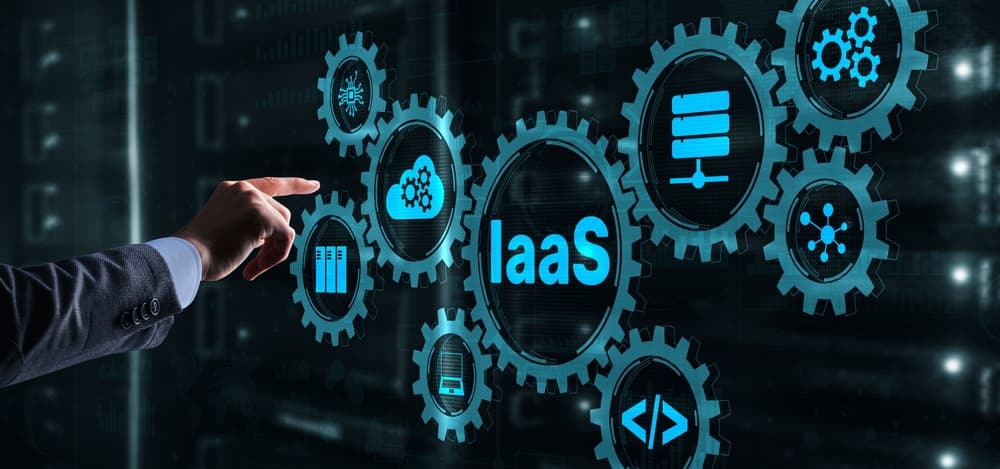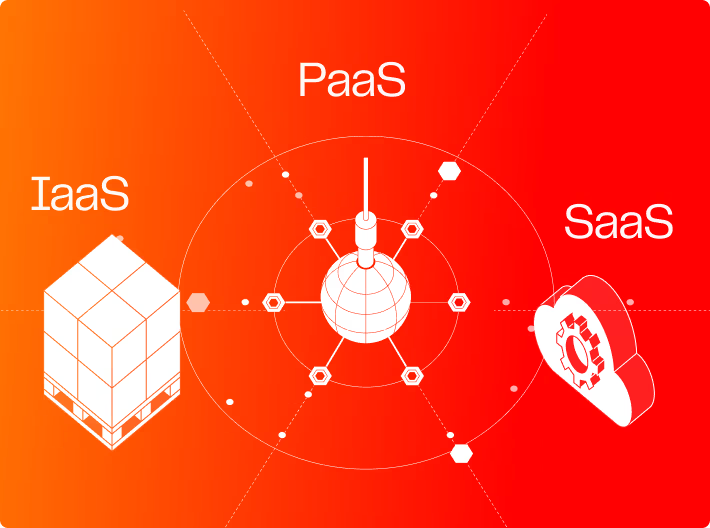Find out once and for all what SaaS versus PaaS versus IaaS really means and learn which cloud service model is best for you and your business's needs.
Cloud computing moves our most in-demand IT resources onto the internet, away from brick-and-mortar offices and into a more accessible space. This helps companies get the necessary software and hardware assistance to grow without burying themselves in expenses and responsibilities.
This guide will dig into the SaaS versus PaaS versus IaaS debate, learn about each cloud resource’s pros and cons, and see how clients can select the right systems for their needs.
What is SaaS?
Software as a service, or SaaS, is one of the most instantly recognizable cloud service models. It allows consumers to access software applications via the internet rather than downloading or purchasing software that’s delivered in a physical form and then added to the end user’s computer.
SaaS providers host their applications in the “cloud” — a fancy way of saying the app lives on virtual servers rather than on your device. Every time you sign in, you’re accessing that cloud-hosted app, which could be run from almost anywhere in the world.
Benefits of SaaS
So, why would someone prefer to use SaaS rather than storing the software on their computer, where they know it’s available 24/7?
There are tons of benefits to using SaaS, including:
- Fast and easy access. With traditional software, you must download and install a program before you use it. SaaS software is already installed, configured, and ready to be utilized anywhere, anytime, saving you or your customers valuable time.
- Lower initial investment. SaaS allows you to share the cost of hosting with other companies using the same cloud site. From creation to maintenance, you’re reducing the financial burden across the board.
- Ability to scale faster. With SaaS, there’s no need to buy another server or invest in additional hardware every time you want to launch a new product. Scale up, scale down — everything is already in place.
- Instant upgrades. If you rely on traditional software distribution, you have to mail out or otherwise deliver new downloads or patches to ensure everyone is using the updated version. With SaaS, you make the changes on the provider end, and access is automatic.
SaaS use cases
SaaS is ideal whenever you have software that needs wide distribution, frequent use, and easy access. Although SaaS works for niche products targeting small audiences, the SaaS model is most advantageous when your app will be used by millions. Volume matters here; the more people use your software, the more valuable cloud access can be.
Other prime use cases for SaaS include:
- Live events, such as when people are signing on to view a sporting event and don’t want to download software for a single viewing experience.
- Software developed by startups, which tends to have big ideas but limited capital that would otherwise limit distribution and development options.
- Short-term projects that require lots of collaboration and access for just a few weeks or months, making it less worthwhile to develop and install dedicated software.
- Accessory or peripheral applications that support larger apps, such as an accounting plug-in used to support business operations software.
What is PaaS?

Platform as a service (PaaS) empowers businesses to develop and deploy their proprietary apps using a cloud-based system. Available on demand, PaaS can help organizations through the entire life cycle of their app, ranging from building and testing the software to managing and updating it as needed.
Like SaaS, PaaS includes all the infrastructure necessary to offer an app without overwhelming startup costs. But because PaaS is all about the entire life cycle, its offerings go above and beyond to include tools like database management systems and business intelligence services.
Examples of PaaS services include Microsoft Azure and the Google App Engine.
Benefits of PaaS
PaaS’s broad range of features lets users reap a host of benefits, including:
- Increased offerings without additional staffing. Choosing a PaaS infrastructure means you're not taking on the responsibility of full-time employees or committing to contracts with multiple consultants while still reaping the benefits of their much-needed skill sets.
- Decreased coding time. Piggyback on PaaS to code new apps in less time by stringing together pre-coded components offered by your package or on a piecemeal basis.
- Multi-platform capability. Shop for a PaaS provider that includes development options for mobile devices and browsers as well as desktop computers to make cross-platform app creation even easier.
- Multiple payment options to customize access. Popular pay-as-you-go options allow you to get the tools you need and skip those you don’t. This way, you can fill in the gaps in your internal workflow and switch things up as changes occur.
PaaS use cases
Some specific instances that might call for the use of a PaaS include:
- Developing and managing APIs. It can be challenging to create efficient APIs in a timely manner, but PaaS comes with built-in frameworks that help businesses speed through the process and collaborate with multiple teams across the globe.
- Tapping into the Internet of Things (IoT). The Internet of Things sees everyday appliances and activities connected and managed by a network of tech using various programming languages. PaaS has the bandwidth and utilities to support companies developing IoT-ready and IoT-leveraging apps.
- Migrating existing apps. Because of its broad utility and built-in solutions, PaaS helps organizations re-platform existing applications from home servers to the cloud, where they can re-architect and improve upon them or scale to service a larger audience.
What is IaaS?

Infrastructure as a service (IaaS) offers the end user access to various computing resources from a cloud-based vendor, including servers, networking capabilities, and storage. Those resources are supplied virtually rather than inviting clients to come to a brick-and-mortar location or buy networking setups that must be delivered and constructed.
Benefits of IaaS
The main benefit of IaaS is the opportunity for organizations to manage their data infrastructure efficiently and holistically without being on site. This “plug and play” model means companies don’t have to buy into an entire system when they’re still in the startup phase. Instead, they pay for what they need as they need it.
In short, IaaS offers these advantages:
- Superior flexibility to use what you want and leave the rest, plus scaling when the time is right.
- Ease of access through a simple dashboard or customized API, offering control without the complexity of a system you set up and run yourself.
- User-friendly deployment that emphasizes automation.
- Consumption-based hardware purchases so you aren’t overpaying for underused resources.
- More control over infrastructure.
IaaS use cases
Given the flexibility and scalability of IaaS, it’s best used in the following cases:
- Startups and small- to medium businesses. Organizations with big ideas but limited capital may prefer using IaaS to skip spending on infrastructure and focus on software development.
- Companies that are selective about solutions and features. If you need help with app infrastructure but don’t want to be told what to buy, IaaS offers the flexibility you want.
- Organizations undergoing rapid growth. If what you need tomorrow could drastically differ from what you need today, IaaS may be the best choice for your company.
- E-commerce companies. E-commerce is a highly variable industry that often sees slow periods and seasonal rushes. Many online retailers prefer IaaS because they can scale up when busy and dial back during revenue slumps.
SaaS vs. PaaS vs. IaaS: Key differences
You’ve seen IaaS, PaaS, and SaaS explained, but that’s not necessarily the end of the story. What are the true differences between these cloud-based service solutions, and how do you know which one suits your needs?
It’s primarily a case of management ease versus control. How much do you want to be involved?
- SaaS has the most service-provided resources. Your provider will manage almost everything — a relief for organizations that don’t want to be burdened by everyday app operations. But the flip side is that you’ll have far less control over factors such as runtime and data storage.
- PaaS splits the difference between SaaS and IaaS. You manage your applications and data, and the provider handles everything else. This shared-responsibility approach is often the best of both worlds, with the platform doing the heavy lifting of hosting and virtualization while clients maintain some control over app development.
- IaaS offers the most control and flexibility by far. You still won’t have to worry about infrastructure, but everything else — including O/S and middleware — is firmly on your plate.
To further muddy the waters, there is XaaS, meaning “anything as a service.” XaaS promises speed and efficiency thanks to subscription-based purchases — allowing access to tons of service providers — but you could wind up with copious downtime and performance issues due to network complexity.
Ultimately, it’s just a matter of what fits your plan, budget, and vision.
Leverage the power of cloud computing with Orderful
Understanding the differences between SaaS, PaaS, and IaaS is crucial for businesses and individuals interested in using cloud computing to achieve success. With this knowledge, you can make informed decisions about which cloud service to employ and how to make it work for your company for years to come.
For more information on implementing EDI and other cloud-based technology solutions, speak to an Orderful expert today.
